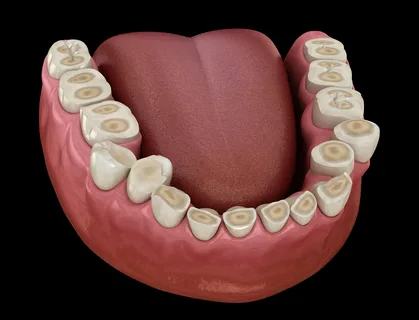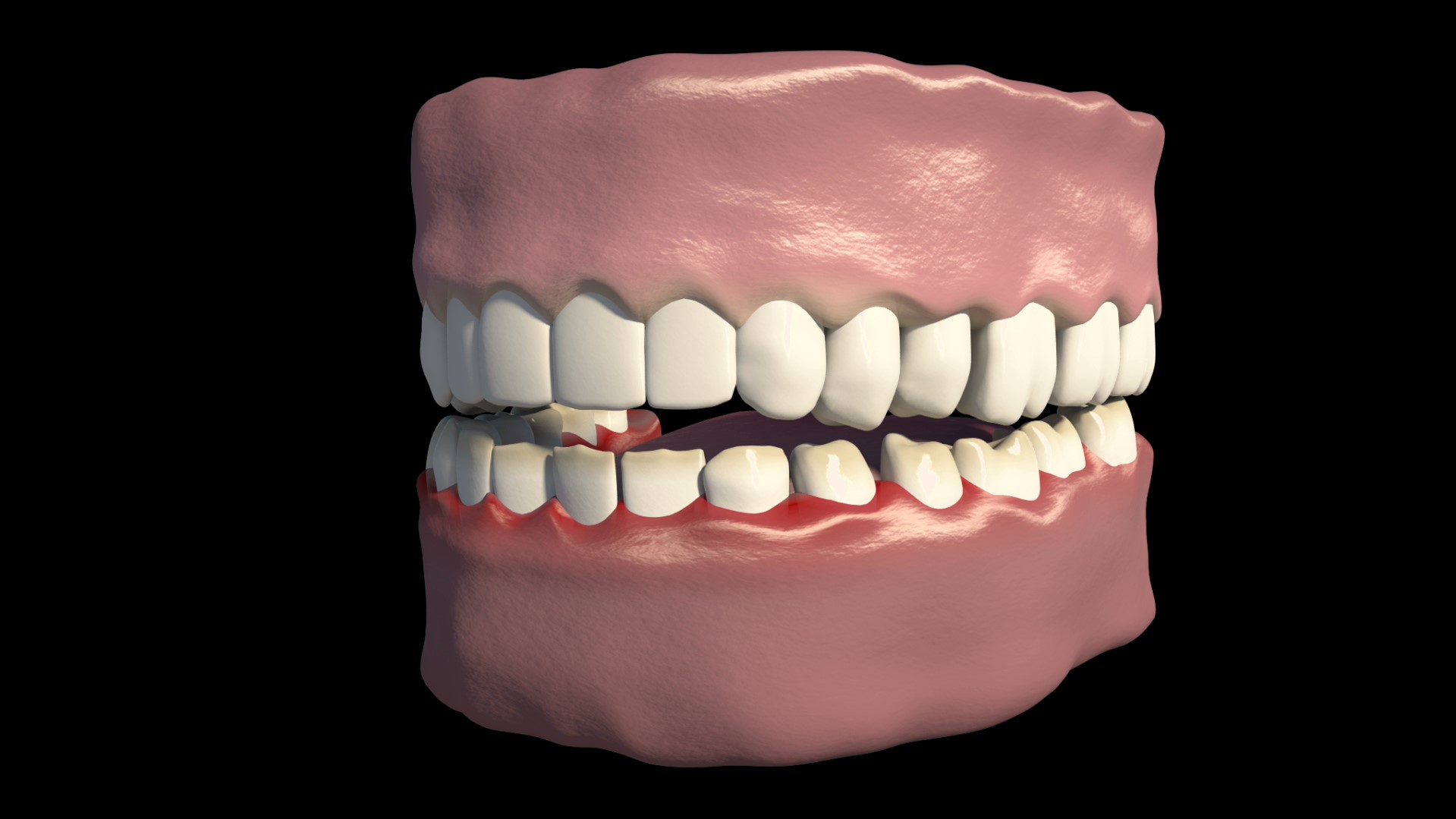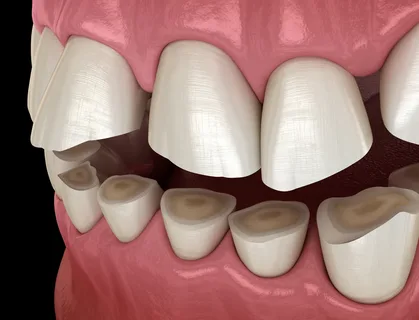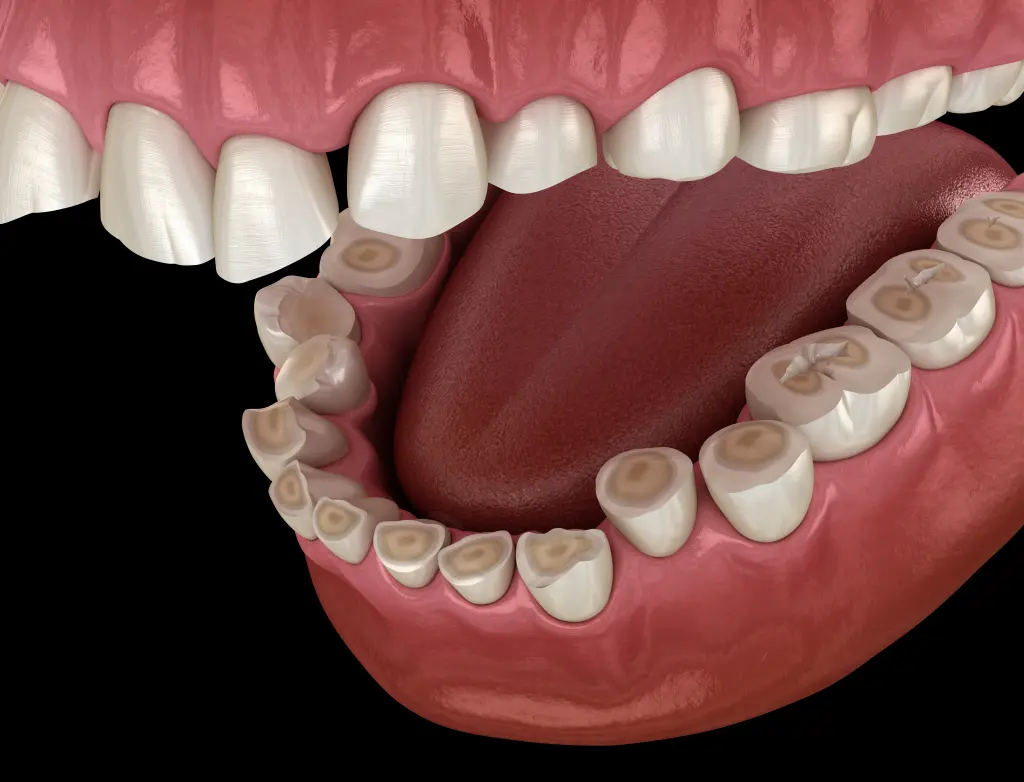Clinic of Pathological Erasability
Machine translation
Original article is written in RU language (link to read it) .
Pathological wear is accompanied by various disorders related to aesthetics, functions of the dental-jaw system, as well as anatomical and histological changes.
Classification of tooth wear based on localization in the webinar Anti-aging: main principles when dealing with pathological wear.
The clinic of pathological wear is diverse, determined by the following factors:
- body reactivity,
- patient's age,
- type of occlusion,
- extent and localization of dental arch defects,
- degree of severity of pathological disorders.
Despite the variety of clinical manifestations, the most typical symptoms of this pathology are distinguished. The first characteristic of this pathology is that the process of tooth tissue wear is not associated with their softening.

Figure 1. Clinical picture of pathological wear.
Main characteristics of pathological wear:
- change in the original anatomy of the tooth crowns,
- increased sensitivity of the dentin,
- decrease in interalveolar height,
- reduction in the height of the lower part of the face,
- impairment of the functions of the temporomandibular joint,
- periodontal diseases,
- change in size and configuration of the alveolar processes.
Not all of the above symptoms are diagnosed in a patient. The presence of certain signs of pathology is determined by the type of wear, typically, some symptoms predominate.
Classification of pathological wear
Different methods of classifying pathological wear are distinguished:
Depending on the stage of the process, it is customary to distinguish:
- within the enamel – physiological;
- enamel and upper layers of dentin – transitional;
- within the dentin – pathological.

Figure 2. Initial signs of wear.
Depending on the severity of the process:
- Grade I, characterized by wear of the upper third of the crown;
- Grade II, characterized by wear of two-thirds of the crown;
- Grade III, wear up to the height of the entire crown.
Depending on the form:
- horizontal, signs of wear are predominantly determined on the oral and buccal surfaces;
- vertical, when wear mainly affects the cutting edges and occlusal surfaces;
- mixed.
By the level of compensation:
- compensated, not accompanied by a reduction in the size of the lower third of the face;
- decompensated, accompanied by a reduction in the size of the lower third of the face.
By extent:
- localized, signs of wear are determined in individual teeth or groups;
- generalized.
Clinical manifestations
Areas of the crown subjected to wear have a smooth, polished-like surface, commonly referred to as facets. In more severe cases, cavities of various shapes form along the edge of the frontal teeth or on the occlusal surfaces of molar teeth, such elements of damage are called usures. The formation of usures is associated with the unevenness of the wear process of individual layers of enamel and dentin. This process is most often observed in deep incisal overlap, which is mainly characterized by vertical movements.

Figure 3. Grade II wear.
Pathological wear often coincides with non-carious lesions of the teeth, predominantly with wedge-shaped defects and hypoplasia.
Worn teeth typically show no mobility, resistance to periodontal diseases, which is due to the shortening of the lever arm as a result of the reduction in the extra-alveolar part.
In radiographs, in most cases, the normal structure of the periodontium is observed, there are no symptoms of bone resorption in the area of worn teeth, and no signs of widening of the periodontal gap. However, against the background of the addition of functional overload (tooth loss, bruxism, occlusion pathology), symptoms of bone destruction appear, and in individual teeth, widening of the periodontal gap is observed.
Increased sensitivity of tooth tissues to various irritants is an important symptom of pathological wear. Hyperesthesia is not observed in all patients; it manifests in the area of individual teeth, less often in all.
The generalized form of wear is accompanied by a decrease in the interalveolar height, as well as the length of the lower part of the face. The severity of these changes is determined by the depth of wear and the type of occlusion, and against the background of defects in the dental arches - their extent and localization.
Pathological wear is a chronic process, thus the loss of tissues of the occlusal surface is often accompanied by reactive changes in the bone structure of the alveolar processes - local hypertrophy. The severity of the latter is influenced by individual characteristics of the patient, but it is less pronounced the faster the progression of the pathological process. If the crowns have worn out over a relatively short period of time, the vacant hypertrophy will be minimally expressed. If signs of hypertrophy are completely absent, the reduction in interocclusal height corresponds to the extent of tooth wear, indicating a decompensated form of wear. In this form, complications from the TMJ and masticatory muscles are most often observed. In the vast majority of clinical situations, forms of wear with vacant hypertrophy of the bone tissue of the alveolar process are diagnosed, with some reduction in the height of the lower third of the face, less than the loss of interalveolar height, these are subcompensated forms.

Figure 4. Grade III pathological wear.
Generalized type of pathological wear sometimes does not accompany a decrease in the height of the lower part of the face. The most challenging variant for planning and subsequent treatment of generalized wear is the compensated form, which is characterized by the absence of a decrease in interalveolar height. In such cases, clinically, the crowns of the teeth may be worn down by more than half, but the height of physiological rest remains normal, approximately 2 mm. Examination of such patients reveals sharply defined alveolar processes, which stand out during smiling and conversation.
The clinic of the disease worsens if generalized erasability is complicated by muscle parafunctions and defects of dental arches. The loss of many pairs of antagonistic teeth increases the functional load on the remaining teeth, which promotes accelerated wear of the tissues of the remaining teeth, leading to functional overload of the periodontium. Preservation of a compensated state of periodontal tissues is possible provided:
- intact dental rows,
- high reactivity of the periodontium,
- normal functioning of the masticatory muscles.
With the decrease in tissue tolerance, decompensation occurs, and destructive processes begin.
The reduction in the interalveolar height, as well as the height of the lower part of the face, is often associated with the development of parafunctions (bruxism), shifting of the lower jaw. The topographical relationship of the structures of the temporomandibular joint changes. This leads to a significant complication of the clinical picture, and it is often practically impossible to determine the cause-and-effect relationship between individual components of the pathogenetic chain (erasability – periodontal disease – bruxism – TMJ dysfunction).
Localized wear is rarely observed, diagnosed against the background of intact dental rows, or with the loss of individual teeth. The lower part of the face does not change, but with increased wear of some groups of teeth, hypertrophy of the bone area occurs where the worn teeth maintain contact with the antagonists.
Pathological wear caused by harmful habits is encountered.
Pathological wear against the background of bulimia. Acid from the stomach affects the oral surface of the upper frontal teeth. The condition of the tooth tissues resembles the clinical picture of erosion (tissue density is unchanged, enamel is shiny, hyperesthesia may join, tissue staining), the difference is in the surface of the lesion.
The electroexcitability of the teeth is sharply reduced, sometimes completely absent in pathological wear, indicating serious degenerative disorders, pulp necrosis.

Figure 5. Pathological wear of teeth.
The most severe complication of generalized wear is the development of TMJ dysfunction. However, this complication is only observed in some patients with pathological wear, in certain forms: a decompensated form, combined with defects of the dental arches and malocclusions.
The clinical picture of TMJ dysfunction depends on the following factors:
- general diseases of the patient,
- their age,
- mental status,
- presence of occlusal disorders,
- forms of wear,
- severity of pathological wear,
- presence of periodontal diseases.
Main symptoms: joint pain, with the presence of bruxism the pain becomes diffuse, and pain sensations also spread to the masticatory muscles.
Asymptomatic occlusal disorders in pathological wear at the webinar Rehabilitation of patients with tooth wear.

/public-service/media/default/509/Uf8w4_671f5e937c60e.png)
/public-service/media/default/573/wsedP_688b14f5d4ae9.jpg)
/public-service/media/default/575/suWYa_688b15a42ab5b.jpg)
/public-service/media/default/574/xSI0H_688b153a45b94.jpg)